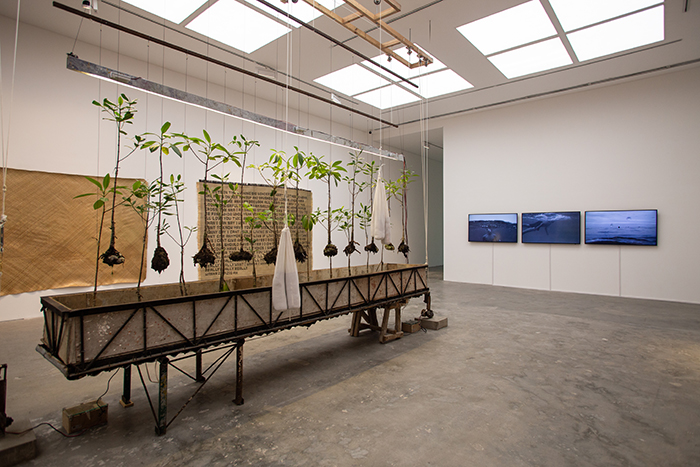Carlos Quijon, Jr on a series of works that consider humankind’s ability to adapt to ecological crises
At the centre of Martha Atienza’s solo exhibition is a mechanism involving a tank of water (Equation of State II: Rhizophora stylosa, all works 2019). In it are a number of small aquarium fish; above it are a row of mangrove saplings hanging on a string. A system of automated weights and pulleys drops the mangroves into the water to moisten their roots, then draws the plants up again, evoking the life of mangroves as they are submerged in tidal waters.
This exhibition, which includes new installation and video works, builds on Atienza’s interest in the relationship between humans and the ecologies in which we live. This time, the artist explores concerns of the climate crisis, particularly as it involves ecological decline and human resilience.
Scientists have described some climate risks as ‘slow-onset events’ (sea-level rise, water-temperature rise, ocean acidification), and the exhibition’s slow, gradual flow recreates this condition to the point at which one wonders if this thematisation feels too deliberate and mediated. The unhurried pacing can be seen in the two videos in the show, which are titled after specific GPS locations and tide measures.
In Panangatan…, a camera pans along the coast of Bantayan Island (the artist’s ancestral home) in Cebu, where the local community is vulnerable to rising seawaters and consequently receding coastlines. Capturing the lives of fisher-folk, formations of rocks and mangrove forests, the video contains minimal sound and action, except for a scene in which a child dives into the water. Life continues. A similar sense of persistence is evoked in the three-channel video Tarong/ Kaongkod…, showing a diver bobbing amid the waves of the sea. He dives deep, his chest visibly compressing, then rises above surface, chest expanding, as the human body mimics maritime waveform while both submitting to and overcoming the forces of nature. Also exploring the idea of endurance is arguably the most dramatic work of the show, Equation of State I, another plant bath that is mounted in a separate, darkened room. This time, only a single sapling is involved, and a single spotlight illuminates the plant and the pool of water. When the water is disturbed, shimmering reflections are thrown onto the wall. Because the plant is set higher and the interval between dippings longer, a sense of tension is created as the viewer waits for something to happen.
On reflection, then, the darting fish in the first contraption, forced to respond to a recurring disruption, function as a foil to these tropes of endurance and passivity. Might they provide a way to reimagine how human agency asserts itself in times of crisis? Maybe we could cultivate a relation to crisis where we remain anxious but always responsive, and, in certain situations, animated and exuberant – like a flittering school of fish, alert to quivers of light or vibrations of movement.
Martha Atienza: Equation of State at Silverlens, Manila, 7 December – 11 January 2020
From the Spring 2020 issue of ArtReview
